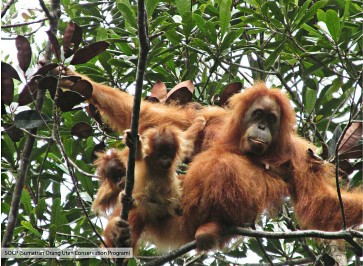Popular Reads
Top Results
Can't find what you're looking for?
View all search resultsPopular Reads
Top Results
Can't find what you're looking for?
View all search resultsHydro project versus rare orangutan
The Indonesian people and government will need to choose between a great ape species and a hydro project that would produce a mere 510 megawatts of electricity and should realize they cannot have both.
Change text size
Gift Premium Articles
to Anyone
 Rare sighting: Twin babies of the critically endangered Tapanuli orangutan species hang onto their mother in a tree in Batang Toru forest, North Sumatra. According to the Sumatran Orangutan Conservation Program (SOCP), twin births generally happen in captivity and rarely in the wild. (Courtesy of the Sumatran Orangutan Conservation Program/File)
Rare sighting: Twin babies of the critically endangered Tapanuli orangutan species hang onto their mother in a tree in Batang Toru forest, North Sumatra. According to the Sumatran Orangutan Conservation Program (SOCP), twin births generally happen in captivity and rarely in the wild. (Courtesy of the Sumatran Orangutan Conservation Program/File)
I
n a recent article, the government was commended on its effective efforts to protect the Tapanuli orangutans, but digging a little deeper indicates the situation might not be as rosy as suggested.
For the past few years, PT North Sumatra Hydro Energy (NSHE) has been looking for political, financial and popular support to push through its hydroelectric dam project in the Batang Toru area in North Sumatra. Hydroelectricity has a nice ring to it. It can produce clean energy, which in a world increasingly affected by climate change and air pollution is important. Unfortunately, the dam is to be built in an area that happens to be the only place on Earth where the Tapanuli orangutan lives.
This species of orangutan was only described in 2017. Some 767 animals are left, which makes it the Earth’s rarest great ape species, rarer than, for example, the mountain gorilla.
Surely if such a rare species occurs in an area that was being developed, all involved parties would agree about the impact of these developments on that species. However, things aren’t that simple. First, there appears to be confusion as to whether the area to be developed for the dam is forested or not. Secondly, there is confusion as to whether there are indeed orangutans in the area scheduled for development.
When, in 2015, the International Finance Corporation (IFC) was still considering to finance the Batang Toru dam, the subsequent environmental impact assessment showed that 5,155 hectares of the 5,968 ha in the affected
area of the hydro project was natural forest. That’s about 86 percent forested.
Strangely, however, a recent article in The Jakarta Post claimed that the entire development area for the hydropower plant consists of rice fields, dry farmland, rubber plantations and other forms of land use, but mentions no forest.

















